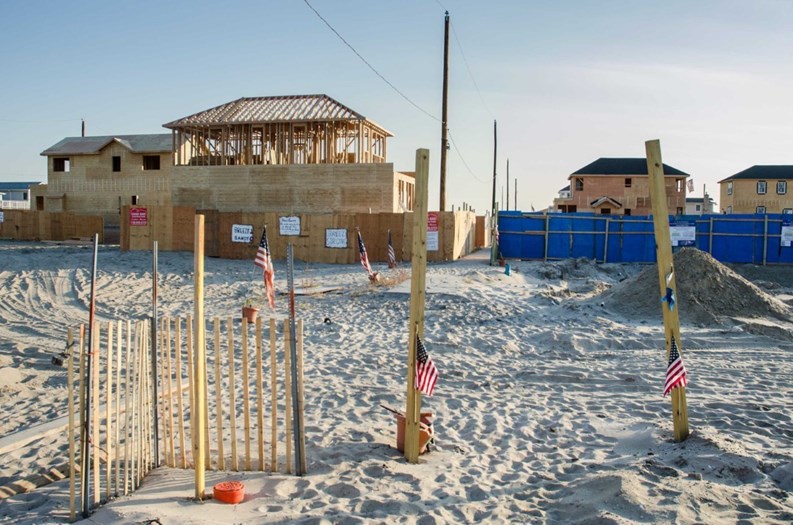At the tail end of October 2012, the nation and the world watched as the innocuously-named Superstorm Sandy made landfall across New York City. Lashing rain, hurricane-force winds, massive flooding, fire and power outages wreaked havoc on communities from the east end of Long Island to the Far Rockaways to Tribeca to Breezy Point, Queens. Parts of Staten Island were destroyed and lives lost, many in the neighborhood of South Beach in Staten Island, and thousands of residents in Lower Manhattan were plunged into darkness when an electrical transformer exploded on the East River, cutting power to a third of the island.
Sandy was responsible for $70 billion in damages (the vast majority of which were in New York and New Jersey), making it the second costliest storm in U.S. history after Hurricane Katrina sacked New Orleans and the Gulf Coast in 2005. It’s been over a year since the storm pummeled New York City, and although billions of dollars in aid has been promised to rebuild devastated areas, many affected residents have yet to replace what the floodwaters swept away. Thousands of displaced New Yorkers and New York State residents are still fighting with insurance companies, slogging through red tape, waiting for government aid—and in many cases, just waiting to return home.
A Slow Recovery
“Staten Island was the most devastated of the communities of Hurricane Sandy. We had the most houses hit and the most houses destroyed,” says David Sorkin, co-chair of the New York Rising Planning Committee on Staten Island.
“It's one year later, and rebuilding is slow in happening. There are still communities here that are not livable yet. Some of these people are living with relatives, some have had to leave Staten Island, some are in houses that are not completely put together yet, some are in rental properties. Very, very few are in hotels. Most of them have found secondary living opportunities.”
Sorkin also notes that with the help of charity organizations, the Federal Emergency Management Agency (FEMA) and local realtors, locating temporary housing for residents displaced by the storm was a transition that happened quickly. “There aren’t a lot of large [multifamily] buildings on Staten Island,” he says. “So when you are looking for alternate housing for somebody, you're really looking for an apartment or house to rent, rather than a big building that may have 100 units empty. Our needs on Staten Island are unique.”
According to Barbara Dershowitz, vice president of AKAM Living Services Inc., a management company in New York City, “In the aftermath of the event, many buildings that hadn't been impacted by the storm itself are now affected by the city's expansion of flood zones to include tens of thousands of buildings previously not included. And many buildings are also feeling the impact of increased insurance costs.”
Aid...and Complications
After the storm hit, it took Congress three months to approve a $60 billion aid package with a wide variety of purposes: funding for FEMA and future catastrophic weather events on the East Coast and around the country, money for infrastructure and direct aid to victims.
New York City is slated to receive $720 million for housing rebuilding in New York City, and New York State is on deck to receive $838 million. But how, where and when aid flows is a complex issue, driven at different levels of local, state and federal government, each with its own set of rules and regulations and political entanglements.
On October 23, 2013, one week before Sandy's one-year anniversary, New York Governor Andrew M. Cuomo hosted the New York Rising Community Reconstruction conference in Albany. Cuomo brought together members of the New York’s 45 local planning committees to collaborate on ideas and strategies for long-term rebuilding efforts in the state's most affected areas. "Homeowners and businesses on Staten Island's East and South shores suffered some of the worst damage in New York State as a result of Superstorm Sandy," Governor Cuomo said at the conference.
“Ever since the devastation caused by Superstorm Sandy, New York State has been working to help families and businesses recover while investing in communities to build back stronger and better than before,” Governor Cuomo continued. “The New York Rising Community Reconstruction program is at the center of this effort, bringing together those that know their own communities best to guide the local rebuilding process. This conference serves as a valuable opportunity for members of the NY Rising Program to share ideas and discuss strategies to make communities stronger than ever before as New York State expands its investment in supporting local recovery and resiliency efforts.”
Located in 102 communities across the state, New York Rising Community Reconstruction Planning Committees are comprised of community leaders, experts and officials who incorporate their community’s unique needs into their redevelopment strategies.
A year after the storm, the city's HOAs, multifamily communities and single-family homes still face an array of headaches and unforeseen snags in their rebuilding efforts. Co-ops, condos and HOAs were affected in different ways. “Relative to the immediate event, some buildings were greatly impacted, others not at all depending on the location. Some saw complete mechanical systems wiped out, while others saw just a minor glitch in their overall day-to-day operation,” says Dershowitz. “Obviously, the buildings located downtown, in the surge areas were greatly impacted due to loss not only of services but of mechanical capabilities caused by flooding.”
As for Staten Island, “A big complication in Staten Island is that there’s a possibility that a lot of communities may never be inhabitable,” says Sorkin. “As FEMA and other organizations look at flood plains and elevation levels, they may make some of these communities obsolete. I think that now there is a new recognition that these areas will always be flooded. If we look at the potential for more so-called '100-year storms,' flooding zones may be more frequent and more catastrophic—and it may be a good idea for these areas to be evacuated in the long term. So that’s what’s happening in dotted areas in our communities, mostly on the East and South shores of Staten Island.”
What About Next Time?
In response to Sandy's havoc, the New York City Council introduced legislation, Intro No. 1085-A, to codify emergency plans for residential and commercial buildings in the event of future weather emergencies.
The resolution amends Title 30 of the administrative code under the Office of Emergency Management (OEM) and recommends that the OEM Commissioner consult with relevant agencies such as the Department of Buildings (DOB) and the Department of Housing Preservation and Development (HPD) to develop guidelines for how residential and commercial property owners shall prepare for and communicate certain information to the tenants in the event of a weather emergency or prolonged power outage.
A few of the amended guidelines will include how window air conditioning units, patio furniture, flower boxes, windows and doors, and other loose items should be secured, whether equipment such as elevators and boilers should be shut down or moved above flood risk areas, the options available to a property owner to rent equipment such as pumps and generators after a weather event or extended power outage, and guidelines for tenants sheltering in place, including seniors and those with disabilities.
“For the buildings, those within a flood evacuation zone should obtain flood insurance. Also, depending on the type of systems a building has, steps can be taken to prevent damage resulting from similar events such as moving mechanical equipment to higher areas in the building and protecting equipment with waterproof barriers,” says Dershowitz. “Boards should be able to rely on their management company to assist them in determining and implementing their best courses of action.”
“Since Superstorm Sandy hit our state a year ago we have taken many steps to rebuild not only in the short term, but also to take measures that prepare New York State for the future from providing tax relief to homeowners and essential assistance for local governments to protecting our coastal areas,” said Governor Cuomo said in a recent press release.
“The interesting thing that the work we are doing with the Governor’s office and New York Rising is long-term resiliency work, which is more focused on infrastructure than on helping people get into their houses or rebuilding at this moment,” says Sorkin. “There are places in Staten Island that are high and dry, and they will always be high and dry—but there are more vulnerable areas, and we are focusing on the infrastructure of those vulnerable areas.”
Ron Beattie, co-chair of New York Rising planning committee for the hamlets of West Sayville and Oakdale in Suffolk County echoes Sorkin’s sentiment that Governor Cuomo is focusing on preparation for future catastrophic weather events.
“There are a number of different programs that are going on. The program that we are involved in is really to rebuild resiliency for future weather events, so it’s not really rebuilding, per se,” he says. “We’re actually further along in the game than many other communities. The main reason is because the state has provided us with really good engineering consultants. Ironically, what we're doing is embracing the same waterfront that caused so much damage for us. We want to open up some areas of the waterfront for public access that would help our community economically, but more importantly we want to improve the health of our wetlands so that they can act more like a sponge than they have been in certain areas.”
Another hard-hit area, Breezy Point, a private beach community in Queens, which was devastated by fire and raging flood waters due to the storm surge and high winds, is just starting to rebound. About 350 of the nearly 3,000 homes in Breezy Point were wrecked beyond repair from flood or fire during the storm. About half of the 2,837 families have moved back to Breezy, where boarded-up houses sit next to others with Halloween decorations in the windows, according to an account by the Breezy Point Cooperative in the Daily News.
Moving Forward
So one year later many New York residents are still on the road home. It is surely to be a long, arduous trek but certainly not impossible. “It is hoped that one positive outcome of Sandy is a heightened awareness among co-op and condo boards that disaster planning in advance of a disaster is critical,” says Dershowitz. “Boards, owners and residents must be able to count on management to take a leadership role in such circumstances.”
Christy Smith-Sloman is a staff writer with The Cooperator.







Leave a Comment